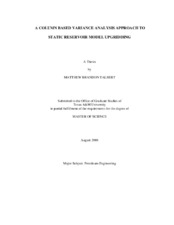| dc.contributor.advisor | Datta-Gupta, Akhil | |
| dc.creator | Talbert, Matthew Brandon | |
| dc.date.accessioned | 2008-10-10T21:02:03Z | |
| dc.date.available | 2008-10-10T21:02:03Z | |
| dc.date.created | 2008-08 | |
| dc.date.issued | 2008-10-10 | |
| dc.identifier.uri | https://hdl.handle.net/1969.1/86055 | |
| dc.description.abstract | The development of coarsened reservoir simulation models from high resolution geologic models is a critical step in a simulation study. The optimal coarsening sequence becomes particularly challenging in a fluvial channel environment where the channel sinuosity and orientation can result in pay/non-pay juxtaposition in many regions of the geologic model. The optimal coarsening sequence is also challenging in tight gas sandstones where sharp changes between sandstone and shale beds are predominant and maintaining the pay/non-pay distinction is difficult. Under such conditions, a uniform coarsening will result in mixing of pay and non-pay zones and will likely result in geologically unrealistic simulation models which create erroneous performance predictions. In particular, the upgridding algorithm must keep pay and non-pay zones distinct through a non-uniform coarsening of the geologic model.
We present a coarsening algorithm to determine an optimal reservoir simulation grid by grouping fine scale geologic model cells into effective simulation cells. Our algorithm groups the layers in such a way that the heterogeneity measure of an appropriately defined static property is minimized within the layers and maximized between the layers. The optimal number of layers is then selected based on an analysis resulting in a minimum loss of heterogeneity.
We demonstrate the validity of the optimal gridding by applying our method to a history matched waterflood in a structurally complex and faulted offshore turbiditic oil reservoir. The field is located in a prolific hydrocarbon basin offshore South America. More than 10 years of production data from up to 8 producing wells are available for history matching. We demonstrate that any coarsening beyond the degree indicated by our analysis overly homogenizes the properties on the simulation grid and alters the reservoir response. An application to a tight gas sandstone developed by Schlumberger DCS is also used in our verification of our algorithm. The specific details of the tight gas reservoir are confidential to Schlumberger's client. Through the use of a reservoir section we demonstrate the effectiveness of our algorithm by visually comparing the reservoir properties to a Schlumberger fine scale model. | en |
| dc.format.medium | electronic | en |
| dc.language.iso | en_US | |
| dc.publisher | Texas A&M University | |
| dc.subject | Reservoir | en |
| dc.subject | Upgridding | en |
| dc.subject | Simulation | en |
| dc.subject | Upscaling | en |
| dc.title | A column based variance analysis approach to static reservoir model upgridding | en |
| dc.type | Book | en |
| dc.type | Thesis | en |
| thesis.degree.department | Petroleum Engineering | en |
| thesis.degree.discipline | Petroleum Engineering | en |
| thesis.degree.grantor | Texas A&M University | en |
| thesis.degree.name | Master of Science | en |
| thesis.degree.level | Masters | en |
| dc.contributor.committeeMember | Wattenbarger, Robert A. | |
| dc.contributor.committeeMember | Efendiev, Yalchin R. | |
| dc.type.genre | Electronic Thesis | en |
| dc.type.material | text | en |
| dc.format.digitalOrigin | born digital | en |


